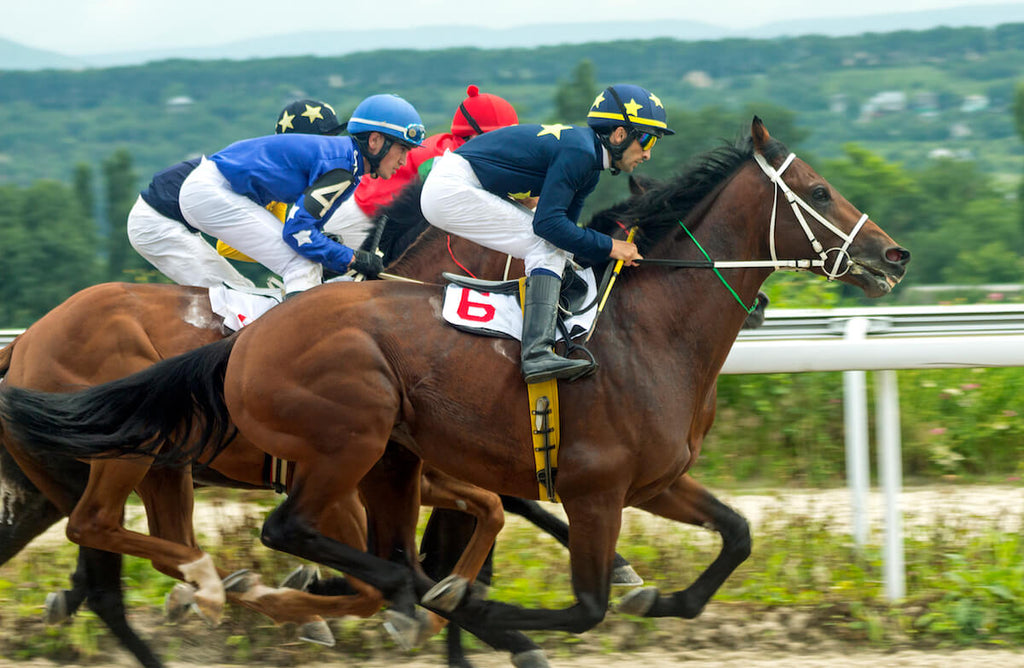Repurposing a racehorse. How to adopt a race horse and giving them a new life and purpose.
Finding life and purpose after a racing career for horses can be challenging, but there are many organizations now that are making a change and contributing to the success of these horses finding a new life after the track. This blog will cover some facts of what happens to retired thoroughbreds and also resources if you are interested in adopting one of these amazing athletes and giving them a new purpose in life.
The Jockey Club, the national registry of thoroughbreds headquartered in Lexington, Ky., reports that approximately 35,000 thoroughbreds are foaled in North America each year, 68 percent of which are destined for a career on the racetrack. Of those horses, nearly 70 percent will win at least one race, but only 5 percent will win a bigger-pursed stakes race, and only two-tenths of a percent will win a Grade I stakes race, which awards the biggest purse and creates the biggest superstars.
Thousands of racehorses retire every year and suddenly find themselves displaced with nowhere to go. Most people assume that a racehorse will retire to a life of being a stud or broodmare and will enjoy the pastured life while they sire the next generation of winners, but this is not always the case.
For every horse winning millions in front of sold-out crowds, there are unheralded thoroughbreds that also race their hearts out each day, but for small purses on cheaper tracks to nearly empty stands. Eventually, lackluster performance or an injury ends these horses' careers. At least 3,000 such racehorses are retired each year, usually by age 6 if not younger, the Thoroughbred Retirement Foundation estimates. Given that most horses live well into their 20s, the question of what to do with them for the next 15 or more years looms. Unfortunately and frequently, the answer is one most horse lovers would rather not think about: Approximately two out of every three thoroughbreds that come off the track, even those that are sound and healthy, are euthanized, abandoned on public land or in empty fields, or slaughtered and their meat is exported to Europe and Japan for human consumption.
The closure of horse slaughterhouses in the United States in 2007, after Congress barred the Department of Agriculture from using funds to conduct horse slaughter inspections, did not diminish the phenomenon much. The USDA estimates that more than 90,000 horses were exported to Canada and Mexico last year for slaughter. The Livestock Marketing Association, which advocates the resumption of horse slaughter in this country, puts the number at more than 120,000. By contrast, in 2006, horse slaughter in the United States and the export of horses for slaughter tallied about 150,000, according to the USDA.
Efforts to stop horse slaughter have gained momentum in recent years as public awareness has grown. Last year in the House and Senate, bills were introduced that would prohibit trafficking in horses for human consumption of their meat. In December, the New York Racing Association announced that it would ban any trainer or breeder who sells a horse to slaughter. Other mid-Atlantic racetracks also have no-slaughter policies on the books, including Pimlico and Laurel Park in Maryland, Colonial Downs in Virginia and Charles Town and Mountaineer Park in West Virginia.
The successful racing career of a colt or stallion who has won some notable races will most likely be shorter, where owners prefer to put him to stud before they must geld him or he suffers injury. A horse of this caliber must race and win only a few races to confirm his talents before he is put to stud.
Most often a colt must be gelded at around 3 or 4 years of age (depending on maturity) in order to continue his racing career. Unless a colt is particularly successful and/or comes from a very popular or respected bloodline, chances are that horse will be gelded to continue racing as he would not be a popular or high earning stallion anyway.
Most successful geldings can race until 7 or 8 years old, sometimes even older.
Mares can continue racing till that age too. However, mares can be much moodier than geldings and some become broody and lose interest in racing before they reach 5 or 6. Other mares and geldings will let you know soon enough if they don't want to race anymore, and it happens. They refuse to jump out of the starting stalls or amble along at the back of the field as though they are sightseeing. This is a sure sign that the horse just doesn't enjoy the racing experience anymore. Some horses really enjoy their race day outings so if they are successful on the track, it is an easy decision to let them continue racing.
There are many organizations that rescue and re-purpose these racehorses and give them a new opportunity to enjoy the rest of their lives. These are just a few listed below.

